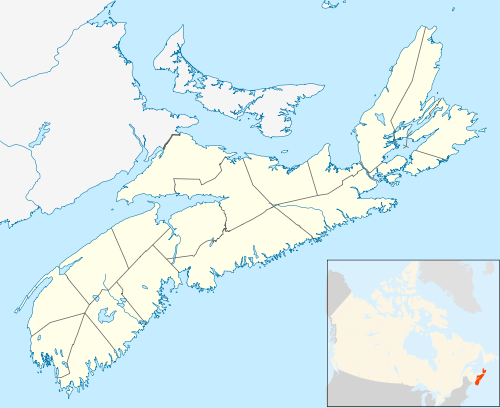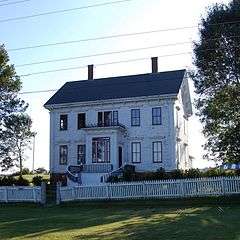Maitland, Hants County, Nova Scotia
Maitland, East Hants, Nova Scotia (originally known as Jean Peter's Village) is a village in the East Hants, Nova Scotia municipal district, and home to the historic Lawrence House Museum,[1] part of the Nova Scotia Museum. The community was part of the Douglas Township until it was named Maitland after Governor General of Nova Scotia Peregrine Maitland (1828–34), when building the Shubenacadie Canal was first attempted (1826–1831). The Canal was supposed to start at Maitland, Nova Scotia and run through the province to Maitland Street, Dartmouth, the canal being "bookended" by two "Maitland" landmarks.[2]

History
Maitland was first settled by the Acadians. After the Acadian exodus from the region (1750), the village was eventually settled by Ulster Scots whose descendants became shipbuilders.
Acadians
Maitland was settled by Jean Pitre (i.e., Peters), son of Jean Denis Pitre, prior to the Acadian Exodus. Oral tradition states that the Oak Island Graveyard was an Acadian burial ground, which was consecrated by Abbe Jean-Louis Le Loutre. Oral tradition also states that a path which connects the "French Field" in Selma to the cemetery in Maitland is the old Acadian roadway.
Several of Jean Denis Pitre’s children married the children of Noel Doiron and Robert Henry from the neighbouring communities of Vil Noel (Noel, Nova Scotia) and Vil Robere respectively. In 1750 the Acadians at Maitland joined the Acadian Exodus during Father Le Loutre's War and moved to Riviere Nord-Est, Ile St. Jean (present day Hillsborough River (Prince Edward Island)). The former of inhabitants of Maitland died in 1758 during the Expulsion of the Acadians in the sinking of the Duke William.
Ulster Scots (Irish)
After the exodus of the Acadians from Maitland (1750), the land was owned but never settled by Malachy Salter. Decades after the village was vacated by the Acadians, the village was settled by Ulster Scots people such as the Putnams (c. 1771).
Shipbuilding
Maitland emerged as a major shipbuilding centre in the late 19th century. William Dawson Lawrence became the community's most famous shipbuilder. His ship, the William D. Lawrence, was the largest wooden ship ever built in Canada and third largest in the world, was launched at the William D. Lawrence Shipyard in Maitland on October 27, 1874 to one of the largest crowds assembled in Nova Scotia to that date. [3] Every September Maitland celebrates the launch of William D. Lawrence at a weekend festival called "Launch Days".[4] Several other shipyards build large vessels as well, including the barque Calburga, the last large square rigger to sail under the Canadian flag. Today the only remaining remnant of the shipbuilding industry is Frieze and Roy, a general store which has been operating from the 1860s onward.
RCAF Aerodrome Maitland
During World War II the RCAF constructed a aerodrome near the village of Maitland. The Aerodrome acted as a relief landing field for CFS Debert that was located nearby. In approximately 1942 the aerodrome was listed at 45°20′N 63°32′W with a Var. 23.5 degrees W and no elevation specified. The field was listed as "Hard under construction" and had one runways listed as follows:[5]
| Runway Name | Length | Width | Surface |
|---|---|---|---|
| 3/21 | 4,000 feet (1,219 m) | 200 feet (61 m) | Hard |
Architecture

Maitland was Nova Scotia's first Heritage Conservation District. The centre of the village is a Heritage Conservation District because of its many fine and well-preserved examples of Victorian architecture. The styles of architecture include Gothic, Federal, Colonial, Cape Cod (house), Greek Revival architecture, Second Empire (architecture) and Italianate, of which style the Lawrence House shows many fine details.[6]
Notable residents
William D. Lawrence
William Dawson Lawrence was one of the most successful ship builders in the Maritimes, most famous for building Canada's largest wooden ship, the William D. Lawrence. In an unpublished manuscript written in 1880 toward the end of his life, he wrote of the maiden voyage of the William D. Lawrence. He described returning to the place of his birth, Lawrencetown, County Down, Ireland (close to Gilford, Ireland). He also recollects being mortified by a bullfight that he saw in Peru and enjoying the masked ball he attended while in Paris. During one of his stays in London, Lawrence also attended a sermon of the famous preacher and writer Charles Spurgeon.
Lawrence was also a politician and wrote passionately for Nova Scotia's independence in the anti-Confederation Campaign. He ran successfully as a MLA with Joseph Howe running as an MP, both as anti-Confederates in the Hants County elections of 1867. Two years later, much to Lawrence's dismay, Joseph Howe conceded to Confederation and ran in a by-election on a platform for making "better terms" for Nova Scotia within Canada. Howe won which later led to Lawrence's defeat in the following election (1871).
Other notable residents
- Birthplace of Willard Miller, Spanish–American War hero, recipient of the Medal of Honor one of the famous "Miller Brothers".
- Kate McArthur who was made famous through surviving for many days at sea in a lifeboat and then giving birth upon being rescued.[7]
Film
The story for the television drama "The Night They Killed Joe Howe" (1960) (TV drama), starring Douglas Rain, Austin Willis and Star Trek's James Doohan, was located in Maitland, Nova Scotia [8] (Film Review)
References
- Podunk Community Profile: Maitland
- Halifax Street Names: An Illustrated Guide by Shelagh Mackenzie (Editor), 2004
- Maritime Museum of the Atlantic William D. Lawrence Infosheet Archived 2001-01-07 at the Wayback Machine
- Maitland, NS Launch Days Festival Archived 2009-03-06 at the Wayback Machine
- Staff Writer c.1942, p. 21
- Stephen Archibald and Sheila Stevenson. Heritage Houses of Nova Scotia 2003. Formac Publishing.
- Robson, Kate. "Kate MacArthur". East Hants Historical Society. East Hants, Nova Scotia. Archived from the original on July 18, 2011. Retrieved November 25, 2014.
- "Joseph Howe Subject Of Show". The Gazette. Montreal, Canada. October 1, 1960. p. 26. Retrieved November 25, 2014.
- Staff writer (c. 1942). Pilots Handbook of Aerodromes and Seaplane Bases Vol. 1. Royal Canadian Air Force.